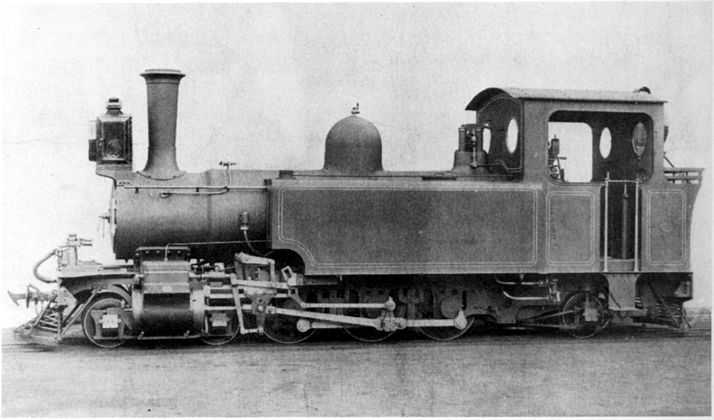CGR NG 4-6-2T 1908
| CGR NG 4-6-2T 1908 to South African NG 4-6-2T 1908 | |
|---|---|
|
CGR narrow gauge 4-6-2T of 1908 | |
| Type and origin | |
| Power type | Steam |
| Designer | W. G. Bagnall |
| Builder | W. G. Bagnall |
| Serial number | 1866-1867 [1] |
| Build date | May & June 1908 (Dispatched) [1] |
| Specifications | |
| Configuration | 4-6-2T "Pacific" |
| Gauge | 2 ft (610 mm) narrow gauge |
| Leading wheel diameter | 22 in (559 mm) |
| Driver diameter | 33 in (838 mm) |
| Trailing wheel diameter | 22 in (559 mm) |
| Wheelbase |
6 ft 3 in (1.905 m) coupled wheels 4 ft (1.219 m) bogie 19 ft 1 in (5.817 m) engine |
| Length | 27 ft 8 in (8.433 m) over couplers |
| Height | 10 ft 6 in (3.200 m) |
| Frame | Bar frame |
| Axle load | 7 long tons 1 cwt 1 qtr (7.2 t) |
| Locomotive weight | 28 long tons 17 cwt (29.3 t) w/o |
| Fuel type | Coal |
| Fuel capacity | 1 long ton (1.0 t) |
| Water capacity | 530 imp gal (2,400 l) |
| Boiler | 4 ft 10 1⁄2 in (1.486 m) pitch |
| Boiler pressure | 180 psi (1,200 kPa) |
| Firegrate area | 7.6 sq ft (0.706 m2) |
| Heating surface: – Firebox | 38.9 sq ft (3.614 m2) |
| Cylinders | Two |
| Cylinder size |
11 3⁄4 in (298 mm) bore 16 in (406 mm) stroke |
| Valve gear | Walschaerts |
| Performance figures | |
| Tractive effort | 9,032 lbf (40 kN) at 75% pressure |
| Career | |
| Operator(s) |
Cape Government Railways South African Railways |
| Number in class | 2 |
| Number(s) | CGR 42-43, SAR NG33-NG34 [2] |
| Delivered | 1908 |
| First run | 1908 |
| Withdrawn | 1929 [3][4] |
The CGR NG 4-6-2T of 1908 is a South African steam locomotive from the pre-Union era in the Cape Colony.
In 1908 the Cape Government Railways placed two 4-6-2T Pacific type narrow gauge steam locomotives in passenger service on the Walmer branch in Port Elizabeth. In 1912 both locomotives were assimilated into the South African Railways and renumbered.[2][3][4]
Manufacturer
Two 4-6-2 Pacific type narrow gauge tank steam locomotives were built for the Cape Government Railways (CGR) by W. G. Bagnall in 1908. The engines were equally powerful tank locomotive versions of the Type B 4-6-0 narrow gauge tender locomotive, also built by Bagnall, but with Walschaerts instead of Stephenson valve gear. They were not classified and were numbered 42 and 43.[3]
Service
Cape Government Railways
Both locomotives were placed in service on the Walmer narrow gauge branchline out of Port Elizabeth.[3] The passenger-only branchline was opened from Valley Junction near Port Elizabeth to the suburb of Walmer in 1906 and was used by up to 22 trains per day.[5]
South African Railways
The Union of South Africa was established on 31 May 1910, in terms of the South Africa Act, enacted by the Parliament of the United Kingdom. One of the clauses in the Act required that the three Colonial Government railways, the CGR, the Natal Government Railways and the Central South African Railways, also be united under one single Administration to control and administer the Railways, Ports and Harbours of the Union. While the South African Railways (SAR) came into existence in 1910, the actual classification and renumbering of all the rolling stock of the three constituent railways required careful planning and was only implemented with effect from 1 January 1912.[2][6]
In 1912 the two locomotives were renumbered no. NG33 and NG34 on the SAR, with the NG number prefix identifying them as narrow gauge locomotives in the SAR registers. They remained in service on the Walmer branch for the duration of their service lives until the line was closed in 1929 and they were withdrawn from service, shortly before a classification system for narrow gauge locomotives were to be introduced by the SAR.[3]
See also
- List of South African locomotive classes
- South African Class NG8 4-6-0
- South African locomotive history
- The 4-6-2 "Pacific"
- Two foot gauge railways in South Africa
References
|
- ↑ 1.0 1.1 Baker, Allan C.; Civil, T. D. Allen (1984). Bagnalls of Stafford – Locomotive Works List (1st ed.). England: The Industrial Locomotive Society
- ↑ 2.0 2.1 2.2 Classification of S.A.R. Engines with Renumbering Lists, issued by the Chief Mechanical Engineer’s Office, Pretoria, January 1912, p. 47 (Reprinted in April 1987 by SATS Museum, R.3125-6/9/11-1000)
- ↑ 3.0 3.1 3.2 3.3 3.4 Paxton, Leith; Bourne, David (1985). Locomotives of the South African Railways (1st ed.). Cape Town: Struik. pp. 113, 156. ISBN 0869772112.
- ↑ 4.0 4.1 Dulez, Jean A. (2012). Railways of Southern Africa 150 Years (Commemorating One Hundred and Fifty Years of Railways on the Sub-Continent - Complete Motive Power Classifications and Famous Trains - 1860-2011) (1st ed.). Garden View, Johannesburg, South Africa: Vidrail Productions. p. 232. ISBN 9 780620 512282.
- ↑ Rollison, Richard (1973-11-23). "Saga of the Apple Express". Evening Post. Retrieved 2011-12-26..
- ↑ The South African Railways - Historical Survey. Editor George Hart, Publisher Bill Hart, Sponsored by Dorbyl Ltd., Published c. 1978, p. 25.
